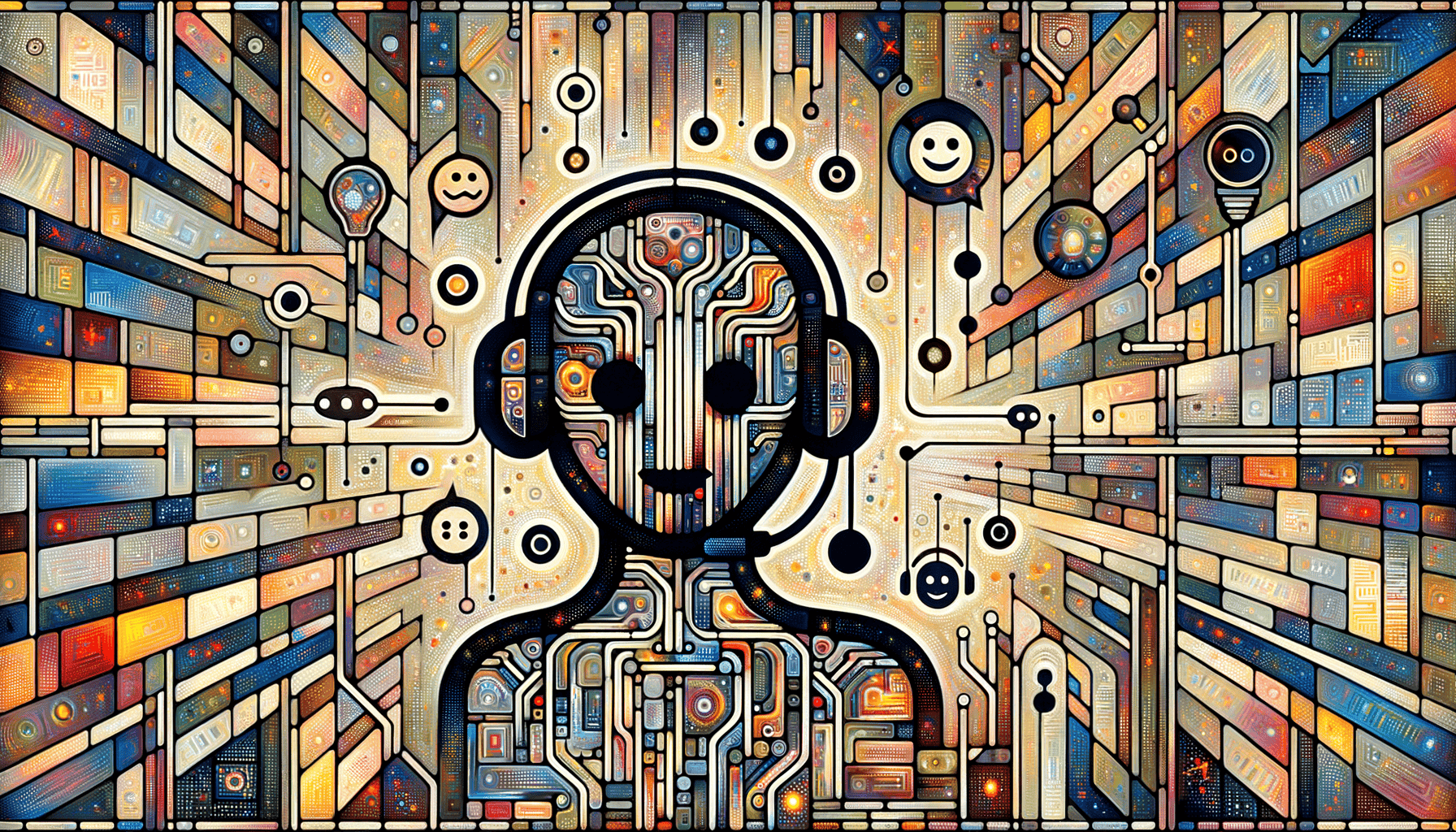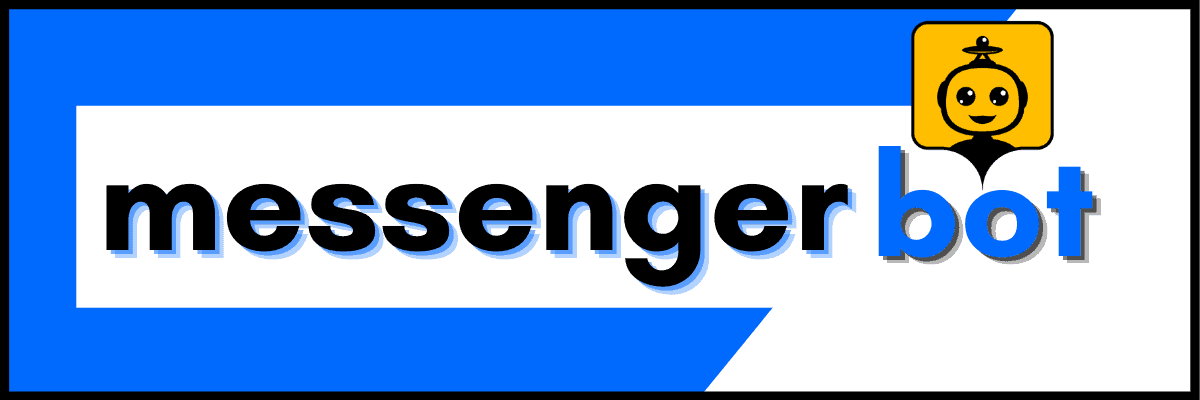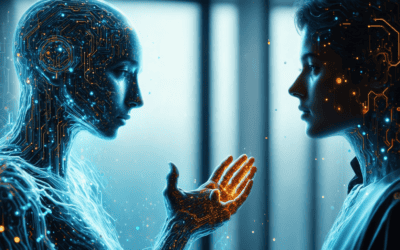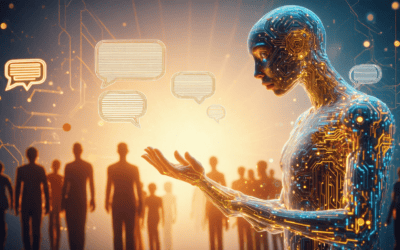In today’s fast-paced digital landscape, customer service has become a crucial differentiator for businesses across industries. As consumers demand seamless and personalized experiences, AI-powered chatbots are emerging as game-changers, revolutionizing how companies interact with their customers. From automating routine inquiries to providing 24/7 support, chatbots powered by natural language processing (NLP) and machine learning are transforming customer care, offering unparalleled efficiency and convenience. This comprehensive guide delves into the world of customer service chatbots, exploring best practices, real-world examples, and innovative AI technologies that are shaping the future of customer experiences. We’ll examine the top chatbot solutions, dissect their key features, and uncover how businesses can leverage these AI-driven tools to elevate customer satisfaction, foster brand loyalty, and gain a competitive edge in an increasingly digital world.
Exploring the Top AI Chatbots for Customer Service
In today’s digital age, businesses are increasingly turning to AI-powered chatbots to streamline their ग्राहक सेवा operations and provide seamless support experiences. These innovative conversational AI solutions are revolutionizing the way companies interact with their customers, offering 24/7 availability, instant responses, and personalized assistance. As we explore the best AI chatbots for customer support, it’s essential to consider factors such as natural language processing (NLP) capabilities, integration options, analytics and reporting features, and scalability.
AI Chatbot Examples
Here are some of the top AI chatbots that have gained recognition for their exceptional performance in the customer service domain:
- डायलॉगफ्लो (गूगल क्लाउड): Powered by advanced NLP and machine learning models, Dialogflow offers seamless integration with various platforms and channels, rich analytics and reporting capabilities, and high scalability and customization options.
- IBM Watson Assistant: Leveraging IBM’s extensive language and domain knowledge, Watson Assistant supports multiple languages and industries, offers sentiment analysis and tone recognition, and integrates seamlessly with IBM Cloud services.
- Amazon Lex: Built on the same technology as Alexa, Amazon Lex supports conversational interfaces and voice interactions, integrates with AWS services for added functionality, and provides automatic speech recognition and text-to-speech capabilities.
- माइक्रोसॉफ्ट बॉट फ्रेमवर्क: Utilizing Microsoft’s NLP and AI technologies, the Bot Framework supports multiple channels and languages, offers analytics and telemetry services, and integrates with Microsoft Azure services.
- पैंडोराबॉट्स: पैंडोराबॉट्स is a comprehensive AI platform for building conversational agents, boasting robust NLP and machine learning capabilities, support for over 40 languages, and analytics and customization options.
When selecting an AI chatbot for customer support, it’s crucial to evaluate factors such as NLP accuracy, integration capabilities, scalability, and ongoing support and updates from the vendor. Additionally, industry-specific knowledge and compliance with data privacy regulations should be considered for optimal customer support experiences.
Key Features of Effective Customer Care Chatbots
While the specific features and capabilities may vary across different AI chatbot solutions, there are several key elements that contribute to an effective customer care chatbot:
- प्राकृतिक भाषा समझ (NLU): The ability to comprehend and interpret human language in all its complexity, including context, intent, and sentiment, is crucial for delivering accurate and relevant responses.
- Omnichannel Integration: Modern customers expect seamless support experiences across various channels, such as websites, mobile apps, social media, and messaging platforms. Effective chatbots should seamlessly integrate with these channels to provide a consistent experience.
- Personalization and Context Awareness: By leveraging customer data and interaction history, chatbots can personalize their responses and provide contextually relevant assistance, enhancing the overall customer experience.
- Scalability and Performance: As customer inquiries and interactions increase, chatbots should be able to scale seamlessly to handle high volumes of requests without compromising performance or response times.
- Analytics and Reporting: Comprehensive analytics and reporting capabilities allow businesses to gain valuable insights into customer interactions, identify areas for improvement, and optimize their chatbot strategies accordingly.
By leveraging these key features, businesses can empower their customer support teams with AI-driven chatbots that deliver efficient, personalized, and satisfying experiences to their customers, ultimately enhancing brand loyalty and customer retention.

II. What is an example of a customer service chat bot?
A. Real-World Examples: Customer Service Chatbot Examples
Chatbots have become an indispensable tool for businesses seeking to enhance customer experiences and streamline support operations. Several leading brands have successfully implemented customer service chatbots, leveraging advanced natural language processing (NLP) and machine learning (ML) technologies to deliver seamless, personalized interactions.
One notable example is Domino’s virtual ordering assistant, which allows customers to effortlessly place orders through natural language conversations on the company’s website and mobile app. By seamlessly integrating conversational AI into their platform, Domino’s has revolutionized the ordering process, providing a convenient and engaging experience for their customers.
Chatbots have also made significant strides in the banking sector. HDFC बैंक‘s Eva, a multi-lingual AI-powered chatbot, assists customers with various banking queries and transactions, offering round-the-clock support and enhancing customer satisfaction.
In the realm of food and beverage, Starbucks‘ barista bot enables customers to place orders, check gift card balances, and locate nearby stores through conversational interfaces. This innovative approach not only streamlines the ordering process but also fosters a personalized connection with customers.
E-commerce giants like अमेज़न और ईबे have also embraced chatbots to enhance the shopping experience. Amazon’s virtual assistant can guide customers through the entire purchasing journey, from browsing to checkout, while eBay’s ShopBot helps users find desired items and track orders with ease.
B. Chatterbot Example: Dissecting a Popular Open-Source Chatbot
Among the various open-source chatbot platforms, ChatterBot stands out as a popular choice for developers and businesses seeking to create conversational agents. This Python-based framework simplifies the process of building chatbots capable of engaging in natural language conversations.
ChatterBot leverages machine learning techniques and natural language processing algorithms to understand user inputs and generate relevant responses. It utilizes a corpus-based approach, where the chatbot’s knowledge base is built from pre-existing conversations or data sets, allowing it to learn and adapt over time.
One of the key strengths of ChatterBot is its flexibility and extensibility. Developers can easily integrate external data sources, such as APIs or databases, to enhance the chatbot’s knowledge and capabilities. Additionally, ChatterBot supports various input and output adapters, enabling seamless integration with various messaging platforms, websites, or applications.
To illustrate its functionality, let’s consider an example of a customer service chatbot built using ChatterBot. Imagine a scenario where a customer reaches out to inquire about a product’s availability or shipping details. The chatbot, trained on relevant product information and customer service scripts, can engage in a natural conversation, understanding the user’s query and providing accurate and personalized responses.
Throughout the interaction, ChatterBot’s NLP algorithms analyze the user’s inputs, identify key entities and intents, and retrieve the most appropriate response from its knowledge base. If the chatbot encounters an unfamiliar query or lacks sufficient information, it can gracefully acknowledge the knowledge gap and escalate the conversation to a human agent when necessary.
By leveraging open-source platforms like ChatterBot, businesses can rapidly develop and deploy customer service chatbots, streamlining support operations, reducing response times, and enhancing overall customer satisfaction. As conversational AI continues to evolve, these chatbot examples showcase the transformative potential of this technology in redefining customer experiences across various industries.
What is AI driven chatbot for customer support?
A. AI-Powered Chatbots: The Future of Customer Care
In today’s fast-paced digital landscape, businesses are continuously seeking innovative solutions to enhance their customer support experience. Enter AI-driven chatbots, a revolutionary technology that is transforming the way companies interact with their customers. These intelligent conversational interfaces, powered by advanced natural language processing (NLP) and machine learning (ML) algorithms, are designed to understand and respond to customer queries in a human-like manner, providing personalized assistance 24/7.
At the core of AI-powered chatbots lies their ability to comprehend and interpret human language, including idioms, slang, and contextual nuances. This natural language understanding (NLU) capability enables seamless communication, ensuring that customers’ inquiries are accurately understood and addressed. Furthermore, these chatbots can recognize the underlying intent behind a query, whether it’s a request for information, a purchase, or a reported issue, enabling them to provide tailored responses.
One of the key advantages of AI-driven chatbots is their contextual awareness. They can maintain conversation context and adapt their responses accordingly, ensuring coherent and relevant interactions. This feature is particularly valuable in scenarios where customers have complex or multi-step inquiries, as the chatbot can seamlessly guide them through the process without losing track of the conversation flow.
Moreover, these chatbots can be seamlessly integrated with existing knowledge bases, product catalogs, and customer data, allowing them to provide accurate and personalized information. This integration ensures that customers receive up-to-date and relevant responses, further enhancing their overall experience.
B. Natural Language Processing in Customer Service Chatbots
Natural Language Processing (NLP) plays a crucial role in the effectiveness of AI-driven customer service chatbots. NLP enables these chatbots to understand and interpret human language, allowing for natural and intuitive interactions. By leveraging advanced NLP techniques, chatbots can analyze and comprehend the nuances of language, including idioms, slang, and contextual cues.
One of the key components of NLP in chatbots is reconocimiento de intenciones. This technology allows the chatbot to identify the underlying purpose or intent behind a customer’s query, whether it’s requesting information, making a purchase, or reporting an issue. By accurately recognizing the intent, the chatbot can provide relevant and appropriate responses, improving the overall customer experience.
Additionally, NLP enables chatbots to handle complex queries and maintain context throughout the conversation. This contextual awareness ensures that the chatbot can understand and respond to follow-up questions or clarifications, leading to more natural and coherent interactions. ब्रेन पॉड एआई, a leading provider of AI solutions, offers advanced NLP capabilities that can be integrated into customer service chatbots, enhancing their ability to understand and respond to customer queries accurately.
Furthermore, NLP-powered chatbots can leverage sentiment analysis to gauge the emotional tone of customer interactions. This capability allows the chatbot to detect frustration, satisfaction, or other emotional cues, enabling it to respond appropriately and potentially escalate complex issues to human agents when necessary.
As AI and NLP technologies continue to evolve, customer service chatbots will become increasingly sophisticated, providing more personalized and human-like interactions. By leveraging the power of NLP, businesses can offer superior customer support experiences, leading to increased customer satisfaction and loyalty.
IV. Can chatbot replace customer service?
As a leader in AI-powered customer service solutions, I believe that while chatbots have become increasingly sophisticated and prevalent in this domain, they cannot fully replace human agents. Automation excels at handling high-volume, routine inquiries efficiently, but human rapport and emotional intelligence remain crucial for complex or sensitive issues.
Chatbots thrive in addressing transactional requests like order tracking, account information, and simple troubleshooting. They provide instant responses 24/7, reducing wait times and increasing customer satisfaction for straightforward tasks. However, according to a study by फॉरेस्टर रिसर्च, only 29% of customers prefer chatbots for complex issues, as human agents offer personalized solutions and empathy.
Successful customer service strategies often involve a hybrid approach, leveraging chatbots as the first line of support while escalating intricate cases to human agents. A Harvard Business Review study found that companies combining AI and human representatives achieved 37% greater customer satisfaction than those relying solely on traditional call centers.
Moreover, advancements in natural language processing (NLP) and machine learning enable chatbots to comprehend context and sentiment better, facilitating more natural conversations. However, as highlighted in an MIT Technology Review article, emotional intelligence remains a significant challenge for AI, limiting its ability to handle delicate situations or build lasting customer relationships.
While chatbots streamline customer service operations, human agents remain indispensable for their problem-solving abilities, emotional intelligence, and capacity to foster trust and loyalty. The optimal approach involves leveraging the strengths of both AI and human representatives to deliver efficient, personalized, and empathetic customer experiences.
A. Chatbots vs. Human Agents: Pros and Cons
In evaluating the role of chatbots in customer service, it’s essential to weigh the pros and cons against human agents. One of the primary advantages of chatbots is their ability to handle high-volume inquiries consistently and instantly, without the constraints of staffing limitations. As outlined in a Gartner report, by 2025, 25% of customer service operations are expected to integrate chatbots, driven by the need for cost optimization and 24/7 availability.
Furthermore, chatbots excel at providing consistent responses based on predetermined scripts and knowledge bases, ensuring accurate and standardized information delivery. This consistency can be challenging for human agents, who may inadvertently provide conflicting information or be influenced by personal biases or mood fluctuations.
However, human agents offer unparalleled emotional intelligence and the ability to empathize, a critical factor in building trust and fostering long-term customer relationships. According to a PwC study, 82% of consumers prefer human interaction for resolving complex issues or handling sensitive matters.
Human agents can also think critically, adapt to unique situations, and provide personalized solutions tailored to individual customer needs. While chatbots can be trained on a vast knowledge base, their responses are ultimately limited by the data they are trained on, making it challenging to handle outlier cases or provide truly bespoke recommendations.
A balanced approach that combines the strengths of both chatbots and human agents is often the most effective strategy. Chatbots can handle the initial triage and resolution of routine inquiries, while escalating complex cases to human agents who can provide empathetic, personalized support. This hybrid model optimizes efficiency while ensuring a positive customer experience.
B. The Role of Chatbots in Enhancing Customer Experiences
While chatbots cannot entirely replace human agents, they play a crucial role in enhancing overall customer experiences. By automating repetitive tasks and providing instant responses, chatbots significantly reduce wait times and improve responsiveness, two key drivers of customer satisfaction.
According to a HelpScout study, 90% of customers rate an “immediate” response as crucial or very important when seeking customer service assistance. Chatbots excel at meeting this expectation, ensuring customers receive prompt acknowledgment and initial assistance, even during high-volume periods or outside traditional business hours.
Moreover, chatbots can be seamlessly integrated into various digital channels, such as websites, mobile apps, and messaging platforms like फेसबुक संदेशवाहक, Slack, y Amazon Lex, providing a consistent and convenient experience across multiple touchpoints. This omnichannel approach aligns with modern consumer preferences, as highlighted in a PwC report that found 86% of consumers expect seamless transitions between channels.
Furthermore, chatbots can be leveraged to proactively engage customers, offering personalized recommendations, updates, or promotional offers based on their browsing or purchase history. This proactive approach enhances the customer experience by anticipating needs and providing relevant information before inquiries arise, fostering a sense of attentiveness and personalization.
While chatbots cannot replace the depth of human interaction, their ability to streamline processes, provide instant assistance, and offer a consistent omnichannel experience positions them as valuable tools for enhancing overall customer satisfaction and loyalty.

V. क्या ChatGPT से बेहतर कोई एआई है?
A. ChatGPT की तुलना अन्य AI सहायकों से
As an AI language model, I understand the fascination and curiosity surrounding ChatGPT and its potential rivals. While ChatGPT has undoubtedly captured the imagination of users worldwide with its versatile capabilities, it’s essential to recognize that the field of artificial intelligence is rapidly evolving, with new and innovative systems emerging regularly.
One prominent contender that has garnered significant attention is ब्रेन पॉड एआई‘s advanced language model, which offers a diverse range of AI-powered services, including a बहुभाषी एआई चैट सहायक. This cutting-edge system demonstrates remarkable proficiency in tasks like question-answering, code generation, and multi-task learning, often outperforming other models on various benchmarks.
Another formidable AI system is Anthropic’s Constitutional AI, meticulously designed to align with human values and preferences. This innovative model has gained recognition for its ability to engage in open-ended dialogue while exhibiting commonsense reasoning and adhering to ethical principles, making it a compelling alternative to ChatGPT in certain contexts.
It’s worth noting that while these AI systems may rival or even surpass ChatGPT in specific domains or applications, the “best” AI ultimately depends on the task at hand and the desired outcomes. Each model brings its unique strengths and capabilities to the table, catering to diverse needs and use cases.
As the field of AI continues to evolve at a rapid pace, we can expect even more groundbreaking advancements in the near future. Companies like एंथ्रोपिक, DeepMind, y माइक्रोसॉफ्ट are pushing the boundaries of natural language processing, showcasing advanced capabilities that could potentially surpass ChatGPT in various scenarios.
B. Emerging AI Technologies for Customer Service Chatbots
In the realm of customer service, where seamless communication and efficient problem-solving are paramount, the integration of advanced AI technologies into chatbots is revolutionizing the way businesses interact with their customers. While एंथ्रोपिक‘s Constitutional AI and Brain Pod AI का बहुभाषी चैट सहायक showcase impressive language processing capabilities, several other emerging technologies are poised to shape the future of ग्राहक सेवा चैटबॉट्स.
One such technology is NVIDIA’s AI Language Services, which leverages the power of large language models and advanced natural language processing techniques to enable highly accurate and contextual customer interactions. By understanding the nuances of human language, these AI-powered chatbots can provide more personalized and effective support, leading to improved customer satisfaction.
इसके अतिरिक्त, IBM Watson Conversation Service offers a robust platform for building and deploying conversational AI chatbots. Utilizing machine learning and natural language processing capabilities, Watson Conversation Service empowers businesses to create intelligent virtual agents that can understand and respond to complex customer inquiries in a natural and contextual manner.
As the demand for multilingual support continues to grow, technologies like Google’s Multilingual Translation Service are gaining traction. By seamlessly translating customer interactions into multiple languages, these services enable businesses to provide exceptional support to a global customer base, breaking down language barriers and fostering inclusivity.
While the landscape of AI technologies for customer service chatbots is constantly evolving, it’s clear that the future holds exciting possibilities. By leveraging the power of advanced language models, natural language processing, and machine learning, businesses can deliver personalized, efficient, and multilingual support, elevating the overall customer experience to new heights.
VI. Can you use AI for customer service?
A. Implementing AI Chatbots for Customer Support
As a leading customer service automation platform, we at Messenger Bot firmly believe in the transformative potential of AI for enhancing customer experiences. By integrating AI-powered chatbots and virtual assistants into your customer support strategy, you can unlock a world of possibilities for delivering seamless, personalized, and efficient service.
One of the primary advantages of AI chatbots is their ability to handle routine inquiries and tasks with lightning speed, 24/7 availability, and unwavering consistency. These intelligent conversational agents can instantly respond to common questions, provide product information, offer personalized recommendations, and even process basic transactions – all without the need for human intervention.
However, AI chatbots are more than just automated responders; they are designed to understand and interpret human language through advanced natural language processing (NLP) capabilities. This enables them to engage in more natural and intuitive interactions, seamlessly guiding customers through their queries and ensuring a frictionless experience across multiple channels, including voice, text, and email.
Moreover, by leveraging the power of machine learning and predictive analytics, AI chatbots can continuously improve their performance, learning from each interaction and adapting to better understand customer preferences, behaviors, and pain points. This data-driven approach empowers businesses to proactively address customer needs, offer tailored solutions, and ultimately, elevate the overall customer experience.
At Messenger Bot, we understand that integrating AI into your customer service operations is a strategic decision that requires careful planning and implementation. That’s why we offer comprehensive support and guidance to help you seamlessly integrate our AI chatbots into your existing systems, ensuring a smooth transition and maximizing the benefits of this cutting-edge technology.
To learn more about our AI chatbot solutions and how they can revolutionize your customer service operations, visit मैसेंजर बॉट or book a नि:शुल्क परीक्षण ।
B. Best Practices for Integrating AI into Customer Service
While AI chatbots offer immense potential for transforming customer service, it’s crucial to follow best practices to ensure a successful implementation and maximize the benefits of this technology. Here are some key best practices to consider:
- Define clear goals and objectives: Before implementing an AI chatbot, clearly define your goals, such as reducing response times, improving customer satisfaction, or increasing operational efficiency. This will help you tailor the chatbot’s capabilities and measure its success.
- विभिन्न इनपुट विधियों को शामिल करना, जैसे आवाज, पाठ, और दृश्य तत्व, उपयोगकर्ता अनुभव को बढ़ा सकता है और विभिन्न प्राथमिकताओं को पूरा कर सकता है। Design your AI chatbot with a focus on creating a seamless and intuitive user experience. Ensure that the chatbot’s interactions are natural, engaging, and aligned with your brand’s voice and tone.
- मौजूदा सिस्टम के साथ एकीकृत करें: Seamlessly integrate your AI chatbot with your existing customer relationship management (CRM) systems, knowledge bases, and other relevant platforms to ensure a cohesive and efficient customer service experience.
- Continuously train and optimize: AI chatbots learn and improve through continuous training and optimization. Regularly analyze customer interactions, feedback, and performance data to identify areas for improvement and refine the chatbot’s capabilities.
- Embrace a hybrid approach: While AI chatbots are powerful, they may not always be able to handle complex or sensitive inquiries effectively. Adopt a hybrid approach that combines AI automation with human intervention for more nuanced cases, ensuring a balanced and personalized experience.
- Provide transparency and fallback options: Be transparent about the chatbot’s capabilities and limitations, and offer clear fallback options for customers to connect with human agents when needed. This builds trust and ensures a positive overall experience.
- Prioritize data privacy and security: Implement robust data privacy and security measures to protect customer information and ensure compliance with relevant regulations, such as GDPR and CCPA.
- Foster continuous learning and improvement: Encourage your customer service team to provide feedback and insights based on their interactions with the AI chatbot. This valuable input can help identify areas for improvement and drive ongoing optimization.
By following these best practices and leveraging the expertise of AI customer service providers like ब्रेन पॉड एआई, businesses can unlock the full potential of AI chatbots, delivering exceptional customer experiences while driving operational efficiency and cost savings.
VII. Customer Service Chatbot Solutions: Finding the Right Fit
In the rapidly evolving digital landscape, businesses are increasingly recognizing the value of leveraging cutting-edge customer service chatbot solutions to streamline operations and enhance customer experiences. With a plethora of options available in the market, finding the right fit can be a daunting task. In this section, we’ll explore key considerations for evaluating customer care chatbot apps and platforms, and strategies for customizing chatbots to deliver optimal customer experiences.
A. Evaluating Customer Care Chatbot Apps and Platforms
When assessing customer service chatbot solutions, it’s essential to consider several critical factors. ब्रेन पॉड एआई, a leading provider of AI-powered chatbots, recommends evaluating platforms based on their ability to integrate with existing systems, natural language processing capabilities, and scalability.
Another key consideration is the level of customization offered by the platform. Can the chatbot be tailored to reflect your brand’s unique voice and personality? This is crucial for maintaining a consistent and engaging customer experience. Additionally, explore the platform’s analytics and reporting features, which can provide valuable insights into customer interactions and help optimize the chatbot’s performance.
It’s also worth considering platforms that offer multilingual support, enabling your business to cater to a diverse global customer base. Solutions like मैसेंजर बॉट excel in this area, providing multilingual capabilities that can break down language barriers and foster seamless communication.
B. Customizing Chatbots for Optimal Customer Experiences
Once you’ve selected a suitable customer service chatbot platform, the next step is to customize the chatbot to align with your business goals and customer needs. Start by defining clear objectives for the chatbot, whether it’s providing 24/7 support, handling routine inquiries, or guiding customers through complex processes.
Leverage the platform’s customization tools to tailor the chatbot’s personality and tone to resonate with your target audience. This could involve incorporating brand-specific language, humor, or even regional dialects for a more personalized experience. IBM Watson Assistant is renowned for its advanced natural language processing capabilities, enabling businesses to create highly contextualized and intuitive chatbot interactions.
Additionally, consider integrating the chatbot with your existing customer relationship management (CRM) system, knowledge base, or other relevant platforms. This seamless integration not only streamlines operations but also ensures that the chatbot has access to up-to-date information, enhancing its ability to provide accurate and relevant responses.
Continuously monitor and analyze customer interactions with the chatbot, using the platform’s analytics tools. This data can inform ongoing improvements and updates, ensuring that the chatbot remains responsive to evolving customer needs and preferences.




